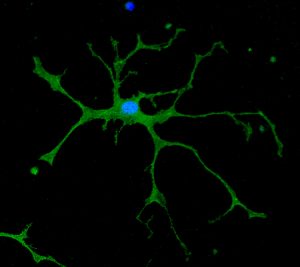The type of brain cells called astrocytes can influence social behaviors and the sense of fear. These are the results of the study carried out by Dr Łukasz M. Szewczyk and Prof. Marta B. Wiśniewska from the UW’s Centre of New Technologies in cooperation with an international team of researchers. The article discussing the research was published in Molecular Psychiatry.
Dr Łukasz M. Szewczyk (the UW’s Centre of New Technologies, the University of California San Francisco) and Prof. Marta B. Wiśniewska (the Centre of New Technologies) have conducted together with Prof. Anna V. Molofsky from the UC San Francisco the research on the cells in the nervous system called astrocytes.
The results of the study regarding the influence of astrocytes on social behaviour have been published in the journal Molecular Psychiatry in the article “Astrocytic β-catenin signaling via TCF7L2 regulates synapse development and social behavior”.
“The influence of astrocytes on social behaviour can occur through modulation of neuronal activity – more specifically, regulation of the number of synapses, as well as stimulation or silencing of synapses by factors expressed by astrocytes,” Dr Łukasz Szewczyk says.
A mutation induced in astrocytes of mouse pups resulted in atypical responses to social stimuli in adult mice, e.g. an increase in social interaction was observed.
“By increasing the number of synapses in the cortex, astrocytes – in the autism model we created – caused mice to interact more eagerly and frequently with strangers, suggesting a reduction in anxiety and fear. The disturbances in complex social behaviours may stem from impairments in astrocytic networks, and therefore, astrocytes might be a new target in the treatment of neurodevelopmental disorders, such as autism spectrum or schizophrenia,” Dr Szewczyk explains.
The article is available in open access on the website of Molecular Psychiatry.
Szewczyk, L.M. et al. “Astrocytic β-catenin signaling via TCF7L2 regulates synapse development and social behavior”, https://doi.org/10.1038/s41380-023-02281-y.




